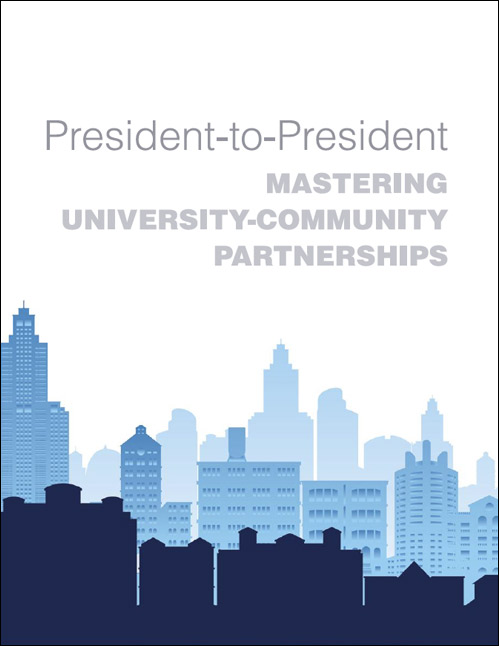IN THIS ISSUE:
Grantee Spotlight: Niagara University’s Levesque Center Channels Resources to the City of Niagara Falls
Continuing a Tradition of Engagement at Bowdoin College
Urban University Leaders Assess Community Partnerships
Urban University Leaders Assess Community Partnerships
 The Coalition of Urban Serving Universities and the Association of Public and Land-Grant Universities has prepared “President-to-President: Mastering University-Community Partnerships,” which synthesizes comments of several urban-based university leaders at a workshop on successful partnerships between institutions of higher learning and their home communities.
The Coalition of Urban Serving Universities and the Association of Public and Land-Grant Universities has prepared “President-to-President: Mastering University-Community Partnerships,” which synthesizes comments of several urban-based university leaders at a workshop on successful partnerships between institutions of higher learning and their home communities.
The Coalition of Urban Serving Universities and the Association of Public and Land-Grant Universities coordinated a workshop for university leaders to further their understanding of partnerships between urban-based universities and local organizations and neighborhoods. Organized by the two national collegiate associations and sponsored by the Annie E. Casey Foundation, the workshop drew on the experience of a panel of five top-level administrators noted for their expertise in partnership building. Panel members candidly discussed the factors driving universities to decide to engage in partnerships, the circumstances in which presidential leadership is needed to make a partnership work, the particular challenges emerging from different types of partnerships, and how to institutionalize a partnership culture across the university. Insights gained from the panel’s discussion are presented in “President-to-President: Mastering University-Community Partnerships,” which is summarized below.
The Decision to Partner
Urban university-community partnerships are forged for various reasons. Some partnerships, such as those with hospitals and schools that provide student training, are essential to the university’s educational curriculum. Anchor institutions form other partnerships stemming from a more general desire to serve the community. For the latter “nonessential” partnerships, university leaders must carefully decide if their benefits justify the costs and risks. The main consideration in deciding whether to engage in a nonessential partnership is how well that partnership aligns with the university’s mission, priorities, and capabilities. Universities are not established to be social service agencies, and all partnerships must first serve the university’s educational mission. A partnership will be unlikely to succeed if it does not advance the university’s mission or priorities, expectations are insufficiently clear, the university does not have the capacity to fulfill expectations, or the partners are not committed to the project. University leaders involved in a failing partnership should identify and fix what can be repaired, and any attempt to redirect the partnership should be clearly explained. If the leaders decide to terminate the partnership, however, they should maintain ties with the former partners because the relationship might be reestablished in the future; leaders should periodically evaluate current circumstances to see if they favor renewing the partnership.
The Role of Urban University Leaders in Successful Partnerships
Once an urban-based university forms a partnership, presidential leadership is crucial at all levels. A president should act as a university and community steward, expressing clear and consistent support for the partnership, communicating the university’s desire and ability to further the partnership, and focusing on important shared values, so that the community will view the university and president as a neutral convener. A critical aspect of stewardship is managing expectations. For example, the president must ensure that each party understands that the partnership’s duration is limited by available funding, often a grant; if the partnership is to extend beyond the initial funding period, the partners should identify additional resources at the outset. Other crucial aspects of managing expectations are to define what constitutes success for each partner — with the understanding that each partner may define success differently — and clarify what the measures of success will be at the beginning of engagement. University leaders must also make clear that the partnership is a joint effort and that the university cannot take sole responsibility for solving all the issues the partnership seeks to address.

Niagara University students participating in the Levesque Institute’s Learn & Serve Niagara program tutor elementary school students at the Francis Center. Credit: Niagara University
Types of Partnerships and Their Challenges
Urban universities typically focus on four types of nonessential partnerships that promote community health and economic well-being. These include health, real estate, education, and neighborhood partnerships, with each type presenting its own set of unique challenges for university leaders. Health partnerships focus on improving community health and are large in scale, encompassing huge costs and an enormous range of issues. The key challenges are in determining the appropriate scale of the partnership and developing the sense of purpose to drive it. Real estate partnerships are long term, with each partner having different objectives. The main challenge presented with these partnerships is balancing the speedy decisionmaking and profit-driven motives of private-sector partners with the nonprofit objectives and slower decisionmaking process of universities. Education partnerships focus on improving the community’s education system from preschool through college and are both long term and complex. The challenges here are to engage all local civic leaders, devise data-based measures of success, and involve the university in teacher preparation.
Neighborhood partnerships focus on projects designed to achieve goals in a defined neighborhood. Neighborhood partnerships involve multiple, diverse groups with competing expectations. They also involve reciprocity between the university and neighborhood groups, which is often difficult to achieve because of power and resource disparities between the participants. Community organizations may expect the university to provide funds or resources that the university lacks, or the university may co-opt the partnership and push the community partner into a passive role by, for example, placing a community representative on the university board. University leaders must therefore ensure that all parties make equal contributions of in-kind resources through full inclusion and active participation in decisionmaking. University leaders must also ensure that the partners define their goals from the outset and agree on standards for measuring success. Doing so helps avoid the disappointments and misunderstandings common to neighborhood partnerships.
Sustaining Partnerships
Institutionalizing community partnerships across the urban university is the key factor in sustaining productive partnerships. Universities can achieve institutionalization through structural means by embedding partnerships in the curriculum, creating a designated “portal” for dealing with partnerships, providing incentives to staff, and hiring individuals who are committed to the partnership concept. Universities can also use various processes to institutionalize their partnerships, including publicizing partnerships within the university to stress their importance in furthering the institution’s goals and establishing relationships that place partners on an equal footing. The latter also encourages partners to view themselves as being co-owners of the project and having a mutual interest in its success. Finally, universities can incorporate data collection, analysis, and dissemination throughout all phases of the partnership to achieve institutionalization. Data can be used to identify the common concerns of partners as well as to measure the impact of partnerships, including the positive impact a university has on the community’s quality of life. Each of these approaches can help sustain partnerships and see them through to a successful outcome.


